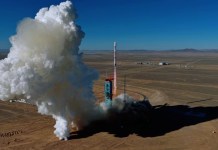With the Indian Space Research Organization’s (ISRO) Chandrayaan-2 rover expected to soft-land on the lunar surface on 7th September, a live show from ISRO has been planned in collaboration with the National Geographic Channel, according to the network.
Israeli Moon Mission Fails; But Why Did Indian Netizens Celebrate The Failure?
On Monday, ISRO successfully launched the ambitious Chandrayaan-2 project via its most potent GSLV-MkIII-M1 rocket from Sriharikota to explore the undiscovered south pole of the moon.
“The live show will slowly drum up the excitement by giving the viewers deeper insights into the historic moment,” the National Geographic said in a statement.

“The show will be an interesting interplay of live coverage and pre-shot stories narrating the iconic nature of the mission and interview of experts from the field to talk about the mission,” it said.
The programme will originate from the Indian Space Research Organisation’s (ISRO) Command Centre, from where the National Geographic will share live updates as Chandrayaan-2 attempts to soft-land on the surface of the moon and become only the fourth nations to do after the US, Russia and China.
Indian Air Force To Get Dedicated Satellite Developed by ISRO
Earlier, an Israeli spacecraft crashed into the moon just moments before touchdown, failing in an ambitious attempt to make history as the first privately funded lunar landing. It had been hoped that the small robotic spacecraft, built by the nonprofit SpaceIL and state-owned Israel Aerospace Industries would beat India is the space race.
The failure was a disappointing ending to a 6.5 million kilometer lunar voyage, almost unprecedented in length, that was designed to conserve fuel and reduce the price. The spacecraft hitched a ride on a SpaceX rocket launched from Florida in February.
For the past two months, Beresheet, which means “Genesis” or “In the Beginning,” travelled around the Earth several times before entering lunar orbit.
Around 20 minutes before the scheduled landing, engine firings slowed Beresheet’s descent. Engineers watched in silence as the craft, its movements streamed live on dozens of screens, glided toward a free-fall.
But then the screens showed the engine misfiring, and the velocity surging as it headed toward the lunar surface. Radio signals from the spacecraft abruptly cut off. Standing before darkened computer screens, controllers declared the mission a failure. The craft crashed near the historic Apollo landing sites.




